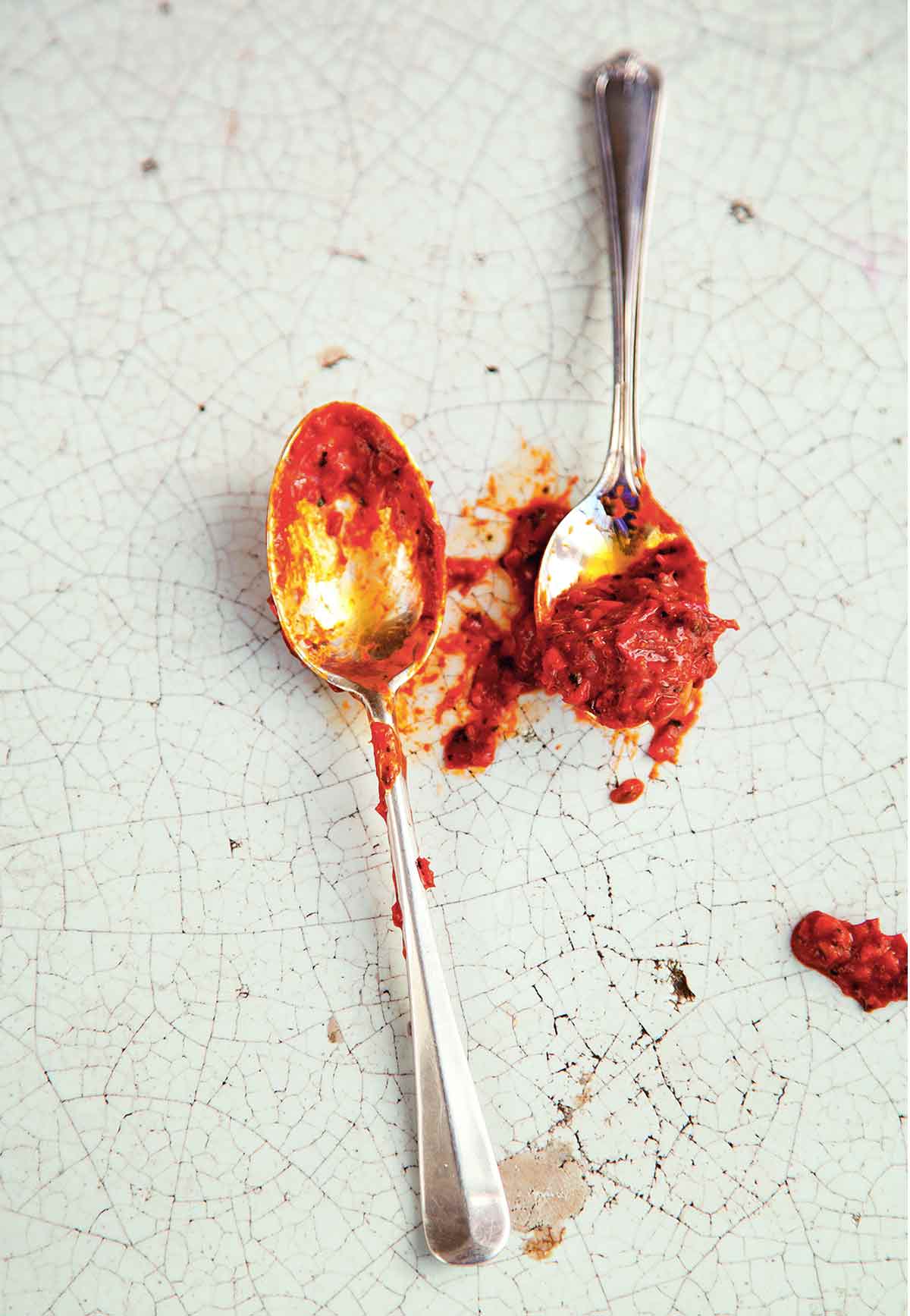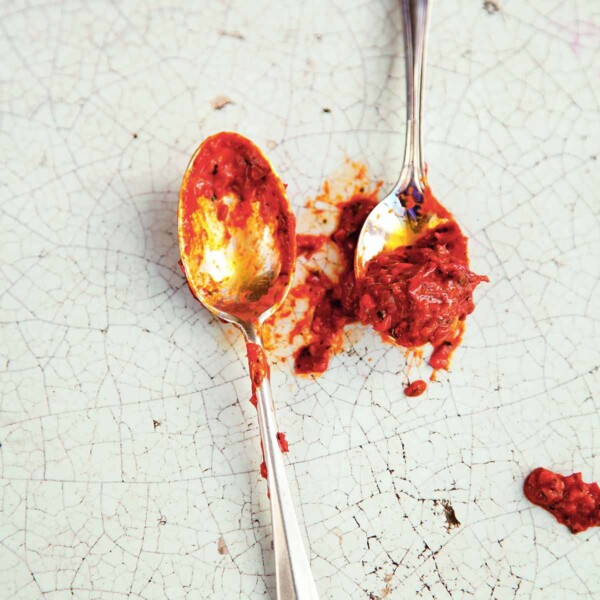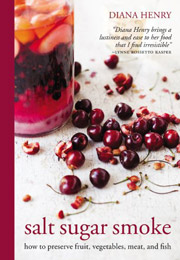
Harissa is a Moroccan chile paste made with roasted chile peppers and spices and, quite frankly, there’s simply nothing else like it on the planet. Nor is there a substitute for homemade harissa, because once you try it, you’ll never go back to store-bought. You’ll just always keep a stash of it in your fridge so you can slather it on everything and anything whenever the craving arises. The trick is that there are as many ways to make this traditional North African condiment of chiles and garlic as there are home cooks. We quite like this way.–Renee Schettler
HOW DO I USE HOMEMADE HARISSA?
If you’re new to harissa, or are simply seeking inspiration for how to use it, here are a few of our favorite things to do with the spicy Moroccan paste…although each day it seems we’re coming up with new ones. Care to let us know in a comment below what you choose to slather with harissa?
- Spoon it over eggs
- Stir it into yogurt for a quick dip for crudités or flatbread
- Add it to soups
- Use as a marinade for chunks of lamb or chicken cutlets before grilling
- Blend a spoonful into a batch of hummus
- Slip under the skin of chicken prior to roasting or smoking
- Toss it in a stir-fry
Want to Save This?

Homemade Harissa
Ingredients
- 2 1/2 teaspoons whole caraway seeds
- 2 1/2 teaspoons whole coriander seeds
- 2 1/2 teaspoons whole cumin seeds
- 5 fresh red chiles (such as serrano, Thai, red jalapeño, etc.), stemmed and seeded
- 5 dried guajillo chiles, stemmed, seeded, and soaked in warm water for 30 minutes, then drained (liquid reserved)
- 8 small garlic cloves, or less to taste
- A few sprigs or 1 small bunch cilantro, leaves only
- Juice of 1 small lemon, (about 2 tablespoons)
- About 5 tablespoons extra-virgin olive oil, plus more for covering
- 1/2 teaspoon salt, or to taste
Instructions
- Toss the caraway, coriander, and cumin seeds in a dry skillet over medium to medium-low heat and toast until the spices start to release their fragrance, 3 to 4 minutes. Pour the spices onto a plate and let cool slightly.
- Tip the cooled spices into a mortar and pestle and pound until coarsely ground.
- Add the ground toasted spices, red chiles, guajillo chiles, garlic, cilantro, lemon juice, olive oil, and salt in a food processor and process until a thick paste forms. If necessary, add a little of the reserved guajillo soaking liquid to achieve the desired consistency.
- Scrape the harissa into a sterilized 1/2-pint jar and slowly pour enough olive oil over the top of the harissa to completely cover the surface. Put the lid on the jar and stash the harissa in the refrigerator for up to 4 months, making sure after each use to always cover the surface of the harissa with a layer of olive oil.

Explore More with AI
Nutrition
Nutrition information is automatically calculated, so should only be used as an approximation.
Recipe Testers’ Reviews
My first experience tasting harissa was at a falafel stand located in the 4th arrondissement of Paris. The harissa was served as a condiment along with the falafel wrap and it was one of those unforgettable food moments. Fast forward to the present and I am so thankful I’ve found this great recipe as it’s absolutely delicious and takes me right back to the flavors I loved in Paris.
Before soaking the dried guajillo chiles, I removed the stems and seeds (the seeds can easily be removed after the stem by tapping the chile gently). I also toasted the chiles for 1 to 2 minutes along with the spices to lend the resulting harissa a roasted depth of flavor. Then I put the spices in my Vitamix to grind them because I don’t have a mortar and pestle. I found that 1/2 teaspoon salt was the perfect amount for my palate. I didn’t need to use any of the reserved chile soaking liquid as the paste came together quite nicely.
I stored my homemade harissa in a brand new clear plastic deli container. I couldn’t let the remaining harissa that was clinging to my food processor blade and bowl go to waste, so I decided to make a hummus to pick up all of the lovely harissa flavors and it was unbelievably good. I will definitely make hummus with harissa again! (For years, I would make hummus and beg my teenage son to try it and he never would. Since finding this recipe, I now make hummus with a tablespoon harissa and my teen dips right into the hummus and loves it! Who knew?! )
Make it, store it, use it—as a marinade, to spice up hummus, to add to soups and stews. Last night I marinated some cubes of lamb shoulder with the homemade harissa for about 30 minutes and grilled them up on skewers. The lamb was so tender and flavorful, just an extra sprinkle of salt was all it needed other than the harissa—delicious. THIS HOMEMADE HARISSA IS SO GOOD. I LOVE IT!
You had me at chile and garlic with this harissa recipe. I’ve always purchased this type of sauce, but never again. I used 10 hot cherry peppers to make the homemade harissa as they were small and their heat was moderate.
I toasted the spices and put them warm into the mortar and pestle. (I didn’t feel the need to allow them to cool before breaking them down.) I pounded them into pieces as small as possible before adding them to the rest of the ingredients in the food processor. I found the resulting paste a little on the thick side for my taste and added about 1/2 cup chile soaking liquid, processing again for another half minute to incorporate it fully. The resulting paste was flavorful without being blow-your-head-off hot. It just had a pleasant heat at the end.
I did stir in a little squeeze of lemon juice (about a tablespoon or so) at the end to brighten the flavor. I used 125-ml (70-mm) jars to send this out as samples for people to taste. I got 3 jars from 1 batch. The results were raves all around. Many said the homemade version had so much more flavor than the store-bought version. Only one person said it wasn’t hot enough. I like that I can control the heat without losing flavor simply by changing the type of fresh chili used. So far I’ve used it in a tomato sauce for eggs, added it to a Portuguese beef stew, even dabbed a little on a spinach pizza, and all were very good. Definitely a do-again recipe.
It’s so easy to make this homemade harissa recipe, I don’t see a need to ever buy a jar of it again. You have quite a bit of flexibility in this recipe to customize the taste. I used just 5 tablespoons olive oil and didn’t need to add any water to get the mixture to blend to a paste in a normal blender.
The harissa perfectly filled a 1/2-pint jar. I used serrano chiles but found that the resulting harissa wanted a bit more heat, so I added 3 Thai chiles to make it a bit hotter. You could also play with the ratio of fresh to dried chiles to alter the flavor a bit, depending on your preference. I made this twice and found that for the brightest flavor, using the least amount of oil you can get by with is the way to go. You need enough oil to form a paste and help the flavors blend, but not too much or it will mute the flavors, especially the lemon.
It’s not mentioned in the recipe, but you could also blend in a small amount of preserved lemon, if you have it, to punch up the flavors even more. Harissa keeps well in the refrigerator and is one of the most useful condiments to have on hand. Using the two batches I made, I rubbed harissa on chicken breasts and grilled them for a quick weeknight dinner; added harissa to a stir-fry of shrimp and peppers; spooned harissa over eggs; and mixed harissa into yogurt for an easy dip for chips and crudités. Versatility is the name of the game for harissa.
I’ve never had Moroccan food before, but if this homemade harissa recipe is what it’s all about, then I’m all in. This sauce is great and goes very well with chicken or beef in place of BBQ sauce. I did a whole roasted chicken on our smoker after rubbing this under the skin and it was incredible. I also used the harissa as a finish for some chicken cutlets and as a BBQ sauce for some wings. It’s a very versatile recipe that can be used many ways.
My older teenage son just loves to spread it on toast. Note that toasting the seeds brings out their flavor, so please don’t use ground spices. I used Serrano peppers as they are my favorite. You may need to add a little more liquid to bring your harissa to the right consistency. I didn’t add the oil to cover because this homemade harissa doesn’t last that long in my home—it’s gone in 2 days.
This harissa recipe was very easy and fairly quick to make. Most of the time spent was soaking the dried peppers, which wasn’t a problem because I had other things to do in the kitchen. I followed the recipe exactly as it was written. As I toasted the whole spices, the house smelled wonderful. I added about 3 ounces soaking liquid reserved from the dry guajillo chilies. It fit perfectly in a 1/2 pint mason jar, which looks really lovely. The color was beautiful and the taste had a nice, not-too-hot flavor.
I loved the warm earthiness of the spices and the homemade harissa received great reviews from my family as well. It’s so good, I may keep refilling this jar and always make a point of having it in the refrigerator. This harissa will definitely be a side for our eggs in the morning. Love, love, love!












